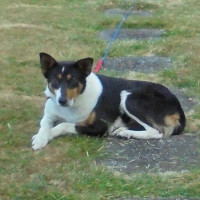Appearance of the Foxton
|
| The Foxton is a small hybrid breed developed from the Toy Fox Terrier and the Boston Terrier. Its short, fine coat comes in several color combinations, including black, tan, white and brindle. Its large, erect ears are inherited from the Boston Terrier. The Toy Fox Terrier's cheerful, goofy eyes are always on the alert. The Foxton's legs are shorter than its body. His tail is always carried high and usually wags. His eyes are dark brown with a dark nose. This curious dog's stance is reminiscent of a machine on the move. |
Temperament of the Foxton
|
| The Foxton is known as an excellent companion as well as a good hunter. His quick reflexes and ability to socialize with others make him a favorable option for families, and he's a wonderful playmate for young children. This adorable breed is intelligent and has a great sense of humor. Its watchdog abilities enable it to protect its family effectively. Positive training is highly recommended to ensure he has good manners and the ability to distinguish between friendly strangers and intruders. This will provide him with the tools he needs to feel at ease with those he doesn't know. This inquisitive dog's personality makes for easy relationships with other dogs, although due to the Foxton's original purpose of hunting small game, getting on well with small animals will require early socialization and training. Its intelligence means it is very likely to listen to commands and quickly grasp your ideas. |
Needs and activities of the Foxton
|
| The Foxton has a high energy level that will require between 45 and 60 minutes of activity a day to keep him from becoming a bit of a nuisance. Your playful dog is a curious explorer who would be more than happy to follow him for walks in the park. Other activities he may enjoy are running, racing and swimming. Two walks a day should be the minimum, and in addition, one to one time with you will be most welcome. An ideal environment for your Foxton is a medium-sized rural home with a fenced yard and a warm climate. Your Foxton is a talented jumper and extra supervision must be provided when in the yard to avoid escapes. Apartment living would be acceptable as long as he gets enough outdoor exercise. |
Maintenance of the Foxton
|
| The Foxton is not considered a hypoallergenic breed and will shed moderately throughout the year. To keep his coat short and smooth, it's important to brush him with a rubber curry brush, a pin brush or a smooth brush (all will work well on his coat) between 10 and 15 minutes to remove dead hairs. Recommended shampoos include hypoallergenic formulas to avoid possible skin irritation. If he has itchy skin, an oatmeal shampoo will help soothe the itch. Consult your vet for advice on how often to bathe this hybrid. Teeth and nail care are also important, with daily tooth brushing and fortnightly nail trimming suggested. Not a stinky dog, he doesn't tend to drool either. |









 English (United Kingdom)
English (United Kingdom)